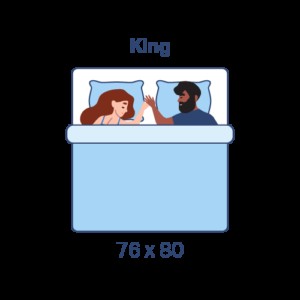Selecting the perfect mattress is crucial for achieving restful sleep and enhancing your bedroom’s comfort. When it comes to mattress sizes, queen and king beds are two of the most popular choices, particularly for couples and individuals who desire more space. Understanding the key differences between a king size bed compared to a queen is essential to making the right decision for your needs and lifestyle. This guide will provide a detailed comparison, exploring dimensions, benefits, drawbacks, and crucial considerations to help you determine whether a queen or king mattress is the ideal fit for your sleep sanctuary.
Queen vs. King Mattress Dimensions: What’s the Difference?
The most fundamental difference between queen and king beds lies in their dimensions. While both offer a standard length, the width is where they diverge significantly, impacting the overall sleeping space and bedroom compatibility.
| Feature | Queen Bed | King Bed |
|---|---|---|
| Width | 60 inches (5 feet) | 76 inches (6 feet, 4 inches) |
| Length | 80 inches (6 feet, 8 inches) | 80 inches (6 feet, 8 inches) |
| Surface Area | 4,800 square inches | 6,080 square inches |


As shown in the table, both queen and king mattresses share the same 80-inch length. This length is generally suitable for most adults, providing ample legroom. However, individuals taller than 6 feet 4 inches might consider a California king for extra length. The critical distinction is the width: a king bed offers a substantial 16 inches of additional width compared to a queen. This extra width translates to significantly more personal space while sleeping.
Key Considerations When Choosing Between a Queen and King Bed
Deciding between a king size bed compared to a queen involves evaluating several factors beyond just dimensions. Consider these crucial aspects to make an informed choice:
Bedroom Size and Space
The size of your bedroom is a primary factor. A king bed, being wider, requires more space and may overwhelm smaller rooms. A general guideline is to leave at least 24 inches of space between the bed and walls or furniture to ensure comfortable movement. While a queen bed is versatile and fits well in most standard-sized bedrooms, a king bed is best suited for larger master bedrooms where it can become a statement piece without making the room feel cramped. Measuring your bedroom before deciding is highly recommended to visualize how each size will fit.
Number of Sleepers and Sleeping Partners
Consider who will be sharing the bed. Queen beds are often comfortable for couples, offering adequate space for two adults. However, couples who prefer more personal space, are larger in size, or have different sleep schedules might find a queen bed feeling cramped. King beds excel in providing ample space for couples, allowing for more freedom of movement and minimizing sleep disturbance from a partner’s tossing and turning. Furthermore, if you co-sleep with children or pets, a king bed becomes almost essential to comfortably accommodate everyone without sacrificing sleep quality.
Budget and Cost
Budget is a significant consideration. King mattresses are generally more expensive than queen mattresses of comparable quality, often costing $100-$300 or more extra. This price difference extends beyond just the mattress itself. Bed frames, foundations, bedding sets (sheets, comforters, duvet covers), and other accessories for king beds are also pricier than their queen-size counterparts. If you are working with a tighter budget, a queen bed can be a more economical choice, allowing you to allocate funds to other bedroom furniture or higher-quality bedding within a smaller size.
Personal Space and Sleep Preferences
Think about your individual sleep habits and preferences. Do you and your partner value personal space while sleeping? Do you tend to spread out or move around a lot during the night? If personal space and minimizing sleep disruption are priorities, a king bed is the superior choice. The extra width allows each sleeper more room to stretch out and reduces the feeling of being confined, leading to more comfortable and undisturbed sleep. Consider your preferred sleeping position as well. Back and stomach sleepers often appreciate more space compared to side sleepers, making a king bed potentially more appealing for them.
Ease of Moving and Transportation
Practicality extends to the ease of moving the mattress. Queen mattresses are significantly easier to maneuver and transport compared to king mattresses. A queen bed can typically fit into standard moving trucks or cargo vans and is easier to navigate through doorways and stairwells. King mattresses, due to their larger size and weight, can be challenging to move, potentially requiring professional movers or specialized equipment, especially in tight spaces or apartment buildings. If you anticipate moving frequently, a queen mattress might be a more convenient and manageable option.
Pros and Cons of Queen Beds
Pros:
- Affordability: Queen beds are more budget-friendly than king beds, both for the mattress and related accessories.
- Popularity and Availability: Queen is the most popular mattress size, meaning a wide variety of mattress models, bed frames, and bedding options are readily available.
- Space-Saving: Queen beds are suitable for most standard bedroom sizes, offering a good balance between sleeping space and room functionality.
- Easier to Move: Queen mattresses are lighter and more compact, making them easier to transport and maneuver.
Cons:
- Limited Personal Space for Couples: Some couples, especially those who are larger or prefer more space, may find a queen bed too cramped.
- Not Ideal for Co-Sleeping: Queen beds can feel crowded when sharing with children or pets.
Pros and Cons of King Beds
Pros:
- Maximum Personal Space: King beds offer generous personal space for couples, minimizing sleep disturbance and maximizing individual comfort.
- Excellent for Co-Sleeping: King beds comfortably accommodate couples with children or pets, ensuring everyone has enough room.
- Luxury and Spacious Feel: A king bed can create a luxurious and spacious feel in a larger bedroom, enhancing the overall aesthetic.
Cons:
- Higher Cost: King beds are more expensive than queen beds, including mattresses and accessories.
- Requires Larger Rooms: King beds are not suitable for smaller bedrooms and may make standard-sized rooms feel cramped.
- Difficult to Move: King mattresses are bulky and heavy, making them challenging to move and transport.
Conclusion: Queen or King – Which Bed Size Rules for You?
Choosing between a king size bed compared to a queen ultimately depends on your individual needs, preferences, and circumstances. If budget and space are primary concerns, and you are a single sleeper or a couple comfortable with close proximity, a queen bed is a practical and comfortable choice. However, if you prioritize maximum personal space, co-sleep with children or pets, have a larger bedroom, and budget is less of a constraint, a king bed is a worthwhile investment for enhanced sleep quality and bedroom luxury. Carefully consider these factors to select the mattress size that best aligns with your lifestyle and sleep priorities, ensuring years of restful nights and comfortable mornings.